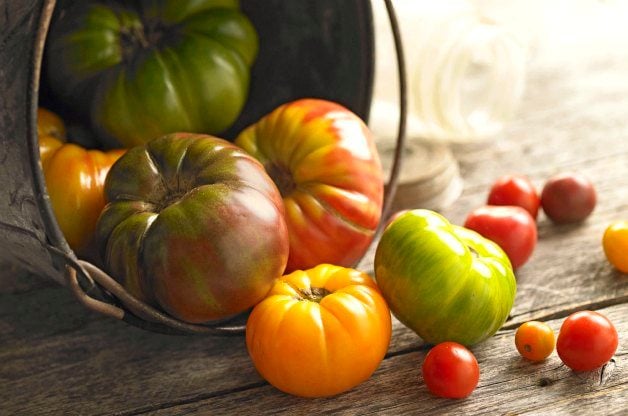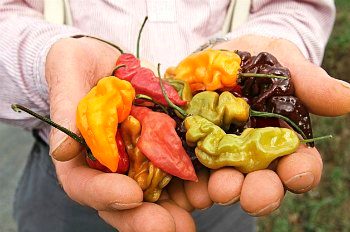Growing Heirloom Vegetables
Updated: Jul. 12, 2021

Join the heirloom revolution and grow your own heirlooms in your backyard vegetable garden.
Long gone is the notion that a tomato should be red. Thanks to the growing popularity of heirlooms, we see orange, purple, green and even black tomato varieties brightening up seed catalogs, garden centers, farmers markets and some grocery stores.
Heirlooms are all the rage, and it’s not hard to understand why. When you plant and nurture them, you’re growing a piece of history. Gardening becomes special when you know you’re sowing the same seeds your ancestors did, long before hybrids and pesticides were introduced.
You can find heirloom varieties of just about anything—carrots, lettuce, potatoes (one variety even has purple flesh!) and so many more. Heirloom flowers and herbs are also popular with gardeners.
Make this the year you plant at least one heirloom in your backyard. You won’t be disappointed.
So what exactly is an heirloom anyway?
The truth is, there’s no official answer. Some say in order to be considered an heirloom, a cultivar must have been introduced before 1951, when plant breeders began to grow hybrids. But others say a true heirloom dates back even further than that, to at least the 1920s.
Kathy McFarland of Baker Creek Heirloom Seeds in Mansfield, Missouri, says her company doesn’t use a cutoff date. As long as the variety is old and has been passed down from generation to generation, it’s considered an heirloom.
It’s the same for Seed Savers Exchange, an organization dedicated to the preservation of heirloom seeds. Rather than use an arbitrary year, it identifies an heirloom by the documentation and generational history of a seed.
It’s not just about dates, though. Most important, in order to be an heirloom, a variety must have been open-pollinated—that is, self-pollinated or pollinated by insects, birds, winds or other natural mechanisms while still maintaining its characteristics. Keep in mind, though, that not every open-pollinated plant is an heirloom. So to be an heirloom really is a mix of things.
Are you thinking about diving into the world of heirlooms for the first time? Kathy’s advice for beginners is to start small, preferably with something you like to eat, since many heirloom varieties are known for tasting better than their modern counterparts.
Kathy also recommends taking good notes. Write down what you grew, how well it did and what the growing conditions were like. The following year, take a look at the results and make changes as needed. Nothing is worse than discovering the best tomato you’ve ever had only to realize you forgot the name of it.
Not into veggies? Heirloom seeds are out there for flower and herb gardeners, too. Baker Creek has a huge selection of heirloom flower seeds available for purchase both on its site, rareseeds.com, and in its catalog.
Some are true antiques. The purplish-black Nigra hollyhock, for instance, was planted by Thomas Jefferson at Monticello and was mentioned by an earlier grower in 1629.
Though these historic flowers and herbs have disappeared faster than heirloom vegetables, they still exist, ready to wow you with the beauty and fragrance that charmed
our ancestors.
If you aren’t yet convinced that heirlooms are for you, sample some at a farmers market. Chances are, you’ll be
a fan. We hear the watermelon is to die for!
Top Heirloom Picks
Jere Gettle, co-founder of Baker Creek Heirloom Seeds and pictured here with his family, shares his favorite heirloom varieties with us. Give them a try!
Beans
Jere recommends beans to any newbie. Nothing’s easier to grow.
Jere’s favorites: Chinese Red Noodle, Purple Podded Pole (above), Roma II
Growing tips: Grow in full sun. Climbing types will need the support of a trellis or fence.
Why we love it: Beans are packed with nutrients, and there’s no limit to the ways you can use them in the kitchen.
Carrots
Why stop at orange ones when you can have purple, red, white or yellow? Remember that the darker the carrot is, the more nutrients it has.
Jere’s favorites: Little Fingers, -Chantenay Red Core, Parisienne
Growing tips: In most areas, carrots should be planted in spring or fall. Northern gardeners can store them right in the garden by covering the roots with straw or leaves right after the ground lightly freezes.
Why we love it: They’re so versatile! Carrots are delicious raw, or cooked in soups and stews.
Cucumbers
Try them in green, white and even orange.
Jere’s favorites: Japanese Long, Lemon Cuke, Dragon’s Egg
Growing tips: Sow seeds directly into soil. A trellis will make cucumbers a lot easier to harvest. They thrive in full sun.
Why we love it: There’s nothing like a fresh, crunchy cucumber straight from the garden. Or go Asian and try steaming or stir-frying them.
Eggplant
Eggplant is fairly easy to grow. There are hundreds of varieties out there in almost every color imaginable.
Jere’s favorites: Little Green, Rosa Bianca, Fengyuan Purple
Growing tips: Grow eggplant indoors from seed in pots about 10 weeks before last frost. Harvest when the fruit is glossy and firm to the touch.
Why we love it: Low in calories and full of nutrients, it can be used as a meat substitute in lots of dishes, so it’s perfect for vegetarians.
Lettuce
As a rule of thumb, the darker the leaf, the more nutritional value lettuce has.
Jere’s favorites: Red Romaine, Little Gem, Forellenschluss
Growing tips: Lettuce will grow in most garden soils. In cool areas, you can grow it through the summer; gardeners in warm climates can harvest lettuce throughout winter.
Why we love it: For salads and sandwiches, lettuce is a must. Many Chinese dishes use steamed lettuce. If you’re feeling brave, give it a shot.
Melons
Some varieties can be grown in as little as 65 days. But if you’re not in a hurry, you have thousands more to choose from.
Jere’s favorites: Old Time Tennessee, Banana, Charentais
Growing tips: Melons thrive in warm, dry areas but need more care in other climates. Knowing when they’re ripe can be tricky; watch for color changes and softening of the fruit.
Why we love it: You can’t beat that sweet taste, and the huge number
of varieties means there’s at least one for every gardener.
Onions
Onion bulbs were among the first things the Pilgrims planted in the New World. Any good cook knows why.
Jere’s favorites: Red of Florence, Flat of Italy (below), Australian Brown
Growing tips: Generally speaking, you’ll want to look for so-called
short-day onions in the South and long-day onions in the North.
Why we love it: Raw, sauteed or deep-fried—onions add a flavor that nothing else can match.
Peas
Most pea varieties are bright green, but you can find snow peas with yellow and purplish-blue pods.
Jere’s favorites: Golden Sweet Snow, Little Marvel, Oregon Sugar Pod II (above)
Growing tips: Most varieties are climbers, so use a trellis or other support system. Garden pea pods are ready to be harvested when they’re plump and bright green. You can harvest edible podded peas before the seeds swell.
Why we love it: Packed with vitamins, protein and fiber, yummy pea pods brighten any meal.

Peppers
They’re easy to grow and a rewarding beginner veggie to try in the garden.
Jere’s favorites: Melrose, Orange Bell, all the Marconi peppers in a variety of colors
Growing tips: Try using raised beds. Peppers love warm soil, good drainage and lots of sunshine.
Why we love it: The options are infinite. It’s fun to experiment with color, size and degree of hotness, from mild bell peppers to sizzling chilis.
Radishes
There are two types: Small salad radishes are commonly eaten raw, while winter radishes are much larger and are good for cooking.
Jere’s favorites: Round Spanish Black, Chinese Red Meat, Chinese Green Luobo (Qingluobo)
Growing tips: Radishes need a lot of organic matter for good drainage.
Plant seeds in full sun, about a quarter-inch deep.
Why we love it: Small salad radishes add crunch to cold foods. To perk up a stir-fry, try radish greens.
Squash
Don’t let the strange appearance of some squashes turn you off. Experimenting with these prolific growers will bring lots of rewards.
Jere’s favorites: Gelber Englischer Custard, Sucrine Du Berry, Yokohama
Growing tips: Grow squash in rich soil with plenty of drainage and in full sun.
Why we love it: Any seeds you don’t save for planting can be eaten. Soak overnight in salt water and then roast them in the oven.
Seed Savers Exchange
Seed Savers Exchange is a nonprofit organization making huge strides in the preservation of heirloom seeds by maintaining a network of gardeners committed to saving and sharing seeds and plants.
Exchange members receive a 10 percent discount on purchases from the SSE catalog and get exclusive publications throughout the year. For more information or to becomea member, visit SSE’s website. Nonmembers can order from the catalog, too, so check out the site and buy your first heirloom
